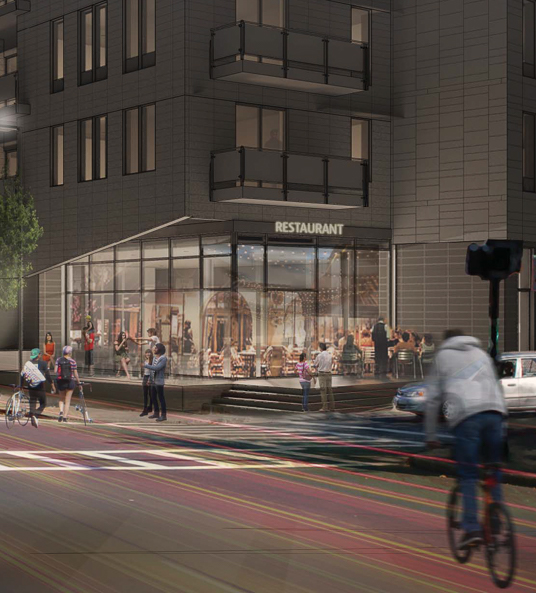GentriWatch: The Fight for 100% Affordability in Egleston Square
Welcome to GentriWatch, where we look for signs of gentrification happening around the city.

Photo courtesy Affordable Housing Egleston
EGLESTON SQUARE in Jamaica Plain has become one of the most contentious battlegrounds for gentrification in Boston, pitting grassroots group Affordable Housing Egleston against developer 3190 Washington LLC and the Boston Redevelopment Authority. The BRA voted last week to approve a project at 3200 Washington Street despite opposition from community members—dozens of whom, along with journalists from the Boston Herald, were barred from the public meeting.
The project would build 76 residential units and meet the BRA’s requirement of 13-percent affordability. That isn’t good enough for AHE, who demands 100-percent affordability for those making $26,000 a year as part of their “Keep It 100% for Egleston” campaign. Earlier this month, AHE held a symbolic 26-hour tent city at the 3200 Washington site.
[Update: BRA spokesperson Nick Martin provided the following statement via email: “Affordable housing is a real concern in Boston, and we’re working with the community and our partners in city government to encourage the creation of more affordable housing. While we can’t solve this complex issue with one project, nearly 24 percent of the units at 3200 Washington Street will be deed restricted as affordable, more than ten percent above what is currently required. We regret that some members of the public were unable to physically be in the room during our recent board meeting due to capacity issues. We strive to make sure our meetings are accessible by having an overflow viewing area in the hallway and by live streaming the proceedings online and on television.”]
“Community members in Egleston envision community control over development, where community members create plans for new developments and have final say over what is allowed in,” the group said in a release. “In this vision, new development will stop displacement, protect the affordability and diversity in their community, and build real affordable housing that people in the community can actually afford.”

Rendering via Boston Redevelopment Authority
“We feel like [gentrification] is spreading, and we need to get a hold of it before it becomes too much,” Adrian Pizarro of AHE says. “We don’t want to be displaced. We want nice things in the neighborhood, but we want them to be affordable.”
Pizarro, 23, has spent his entire life in Jamaica Plain, residing in Egleston Square the last two years.
“My favorite thing [about Egleston Square] is the diversity,” he says. “By that, I mean the culture. Not only black and hispanic, but a little bit of Chinese culture, just a little bit of everything. It’s a place where any kind of people can be around, and I don’t want to see that change. People hang out outside the stores, not because they’re loitering, but because they know the owners. If someone needs help with their car, there are a million people out there to help. That’s what brings the community together.”
• • •
MORE THAN HALF of the 30 one- and two-bedroom condominiums at 197 Union Square in Somerville have sold in less than two months, reports Curbed, after the first 10 units sold in just two weeks.
The asking price for a 1,061-square-foot two-bedroom, two-bathroom unit at the complex located at 197 Washington Street—which includes a roof terrance and a “solar lounge,” whatever that could be—starts at $695,000—nearly $200,000 more than the median home value in Somerville, according to Zillow.
• • •
IN LATE APRIL, the Herald reported that Ahold USA, parent company of Quincy-based Stop & Shop, would be opening a new fresh food market concept in Allston. Located in the space formerly occupied by Staples at 214 Harvard Avenue, bfresh posted this photo of the storefront on their Facebook page Thursday, along with mentions of hand-pressed juices, smoothies, and sushi.
We’re getting ready Allston. bfresh is coming baby! #bfresh #bfreshmarket #freshifyyourlife
Posted by bfresh on Thursday, August 20, 2015
Though Allston is not one of the two areas in Boston (West Roxbury and East Boston) that can be classified as “food deserts”—that is, “census tracts with a substantial share of residents who live in low-income areas that have limited access to a grocery store or other healthy, affordable food retail outlets”—bfresh’s arrival could bode well for better food accessibility in Allston. “I don’t know how it couldn’t unless there is an affordability issue, which is always an issue in Boston with lower income households,” says Kim Zeuli, director of research at the Initiative for a Competitive Inner City, which has studied Boston’s food deserts.
“We think more grocery stores in more neighborhoods are important for a couple of different reasons,” Zeuli says. “They’re important in the short-term for better food access, and most likely, they’ll offer better selection of goods, and often times, at more competitive prices than a corner store. The more grocery stores you have, the more choices you have, and the more they compete on the price, which is good for consumers.”
In the long term, more grocery stores in the area could mean better food resiliency for Allston in the event of natural disasters like a blizzard or flooding, Zeuli says.
• • •
Because GentriWatch only launched last week, it’s worth sharing Slate’s “Am I a Gentrifier?” calculator from last month, developed with Ingrid Gould Ellen, a professor of public policy and urban planning at New York University. It’s methodology is this: “If your neighborhood’s median income is lower than the median income of your city, and your income is higher than your city’s median, you’re a gentrifier.”
Try it out for yourself. And rest assured; this reporter isn’t nearly wealthy enough to be a gentrifier in Brookline.

